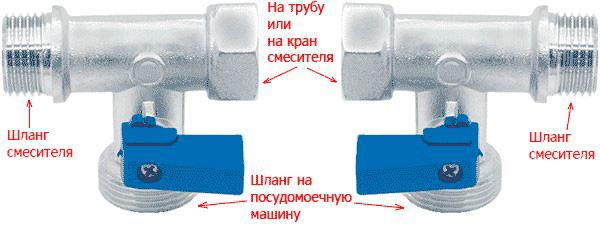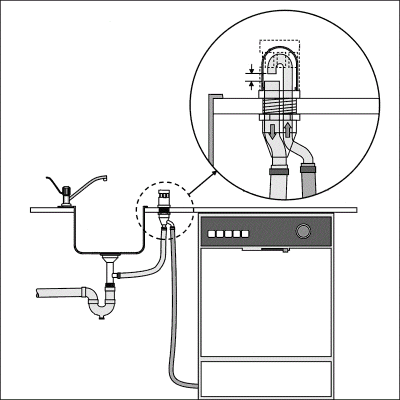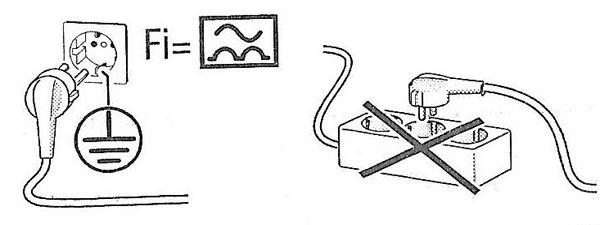Buying a dishwasher is a joyful event for any person. Indeed, starting from the day of purchase, the problem with dirty dishes disappears almost completely. After the purchase, it remains only to connect the device. People with "straight arms" immediately ask themselves the question - how to connect a dishwasher with your own hands? This is really possible, so you can not resort to the services of masters - save money in your wallet and spend it on powder (pills) and salt.
In this review, we will cover:
- About the tools you need to connect the dishwasher;
- About the correct connection to the power grid, sewerage and water supply;
- About the final steps related to checking the connection.
After reading our detailed instructions, you can connect the machine with your own hands and save 2-3 thousand rubles from the family budget.
What to do before connecting the dishwasher

The most important stage is the preparatory stage. We need to properly prepare for the connection of equipment, so as not to stretch the process for a day. And related problems will be solved as they become available. Moreover, there are not so many of them. One of the most important steps is to check the integrity of the machine. Need to check, whether the delivery service personnel damaged your device while carrying it into your house or lifting it to the seventh floor.
Next, prepare a place for dishwasher installation (PM). But before that, let's analyze the existing modifications. There are three main types of PM:
- Compact - placed on the table, in the manner of a microwave or electric oven;
- Freestanding - placed on the floor;
- Built-in - built into kitchen sets.
Connecting a compact machine with your own hands is as easy as shelling pears - it is connected to a water tap or to a special outlet, and the outlet hose is completely placed in the kitchen sink. Next, connect the device to the outlet and proceed to the sink.
With free-standing and built-in devices, everything is somewhat more complicated. We need to connect them permanently, providing a high-quality and reliable connection, without leaks and other problems. For built-in appliances, it is necessary to prepare a niche in the headset - for this we remove the door from the hinges, remove the items in the niche. The device will be located here, but the connection is most conveniently made through the adjacent niche.
It is a little easier to prepare a place for a stand-alone unit - as a rule, this is done even before buying, since you need to decide on the width (45 or 60 cm). Next, we clear the place for installation, determine the distance to the water supply, the nearest outlet and sewer, after which we proceed to the installation process. Mounting a free-standing machine with your own hands is in most cases easier than a built-in one - even an inexperienced master can connect it.
Next, we prepare all the necessary tools and necessary materials. Putting together:
- A siphon with a tap for connecting a drain hose - it is necessary to drain waste water;
- Ball valve tee - needed for a more convenient and safe connection of the machine to the water supply;
- Fum-tape - there is no getting away from it, it will help seal the connections;
- A set of screwdrivers - it was possible not to mention, since they are almost always needed;
- Wrench - will help tighten the nuts on the hoses;
- Construction level - the equipment must stand in its regular place evenly, without distortions;
- Socket - required to connect the dishwasher to the mains (if there is no socket near the installation site).
You will also need auxiliary tools - this is a sharp knife, a drill (if you need to connect a built-in dishwasher) and wire cutters (you will need it when working with an electrician). As for the hoses, then you need to navigate in place - standard length hoses are already included, and if they are not enough, you should purchase longer hoses or extensions.
Connecting the dishwasher to the water supply

If you intend to hook up a brand new dishwasher with your own hands, start by connecting to the plumbing (although some advise starting with the sewer). The vast majority of dishwashers are connected only to cold water, so we do not need a pipe with hot water.We need to connect our dishwasher through a tee with a ball valve - it is necessary to quickly shut off the water in case of removing the dishwasher from its regular place or in case of emergency leakage.
A tee with a ball valve is inexpensive, and having small dimensions, it will not be striking. We shut off the water supply from the central water supply and get to work - we install a tee in the pipe section, sealing the connection with a fum tape. If you have plastic pipes laid, take care of the appropriate adapters or purchase a plastic tee.
Many experts advise connecting dishwashers through coarse filters and softening filters. Thus, you will extend the life of your machine and protect it from damage. Installing your own filters is just as easy as installing the aforementioned tee. The softener can be omitted, as many dishwashers have it, and some detergents already contain softening components.
After installing the tap, connect the supply hose to it. Be sure to use fum tape to avoid leaks. Use the adjustable wrench very carefully so as not to damage the threads. Otherwise, you will have to run to the store for a new tee. After connecting the hose, we try to open the tap is not necessary - the tightness of the connections should be checked after completion of installation work.
Models with hot water connection are connected in the same way, only two tee taps are installed here - for hot and cold water. If you want to connect a single-pipe dishwasher to a hot water supply, consider the following factors:
- Some machines have restrictions on the maximum inlet water temperature;
- Hot water from the central water supply may be too dirty for PM;
- Hot water supply is frequently switched off.
Therefore, we do not recommend connecting dishwashers to hot water.
Connecting the dishwasher to the sewer

What do we need in order to connect the dishwasher to the sewer? The dishwasher is connected to the drain through a special siphon installed under the sink or under the bathroom (similar to the siphon for washing machines). For this procedure we need:
- New siphon;
- Screwdriver for removing the old siphon;
- Drain hose.
note that the maximum length of the drain hose is limited to 1.5-2 meters. Otherwise, the removal of dirty water will be difficult.
How to connect a dishwasher to the sewer with your own hands? To do this, you need to disconnect the old siphon with a suitable screwdriver - we send it to the trash can or storage (suddenly it will still be needed). After that, we install a new siphon in its place, fasten it, check the tightness of the connection.Please note that the drain hose must be positioned so that dirty water flows from top to bottom.
If you're installing freestanding appliances, you can toss the drain hose down the sink. So do many people who connect such equipment with their own hands.
Properly connecting the dishwasher to the sewer requires the use of a check valve - it will prevent accidental "sucking" of dirty water from the sewer back into the dishwasher. Similarly, the correct connection of washing machines is performed. Most often, “sucking in” occurs if the siphon is located too high, almost on the same level as the outlet of the drain from the PM.
Connecting the dishwasher to electricity

Now we know how the dishwasher is connected to the water supply and sewerage - we described these processes in the two previous sections. There is nothing complicated about this, all the work can be done in just an hour (if you do not take into account the installation in kitchen sets). It remains to figure out how to properly connect the dishwasher to the electrical network, using your own hands. The following rules must be observed here:
- The connection must be made without extension cords;
- The use of tees is prohibited;
- It is highly recommended to use grounding.
However, today grounding is recommended for all household appliances, only in domestic houses it is extremely rare - in most buildings the usual two-wire electrical wiring is laid.
Do you want to give your dishwasher a long service life? Then it must be connected to a separate outlet, the wire from which stretches directly to the switchboard. Only in this case you can count on its safety.The wire going to the PM will not be overloaded with many consumers, which directly affects the fire safety and reliability of the entire connection scheme.
So, now we know how to connect the dishwasher to home communications and engineering networks with our own hands. Now we need to check our connections. To do this, turn on the cold water supply, turn on the power supply, turn on the test wash in idle mode (without dishes). During this procedure check the tightness of connections to the water supply and sewerage. If you find a leak, turn off the dishwasher and tighten the connections.
After the final check, the machine can be put in its regular place - make sure that its body does not transfer hoses and wires. Next, we check the correctness of the installation using the building level and re-check. If there are no leaks, we proceed to a full-fledged dishwashing - the dishwasher, which we managed to connect with our own hands, is completely ready for operation. Information about how does a dishwasher work can also be found on our website.
